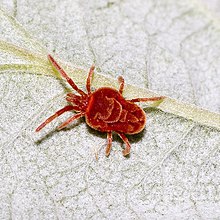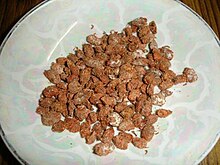
The Acariformes, also known as the Actinotrichida, are the more diverse of the two superorders of mites. Over 32,000 described species are found in 351 families, with an estimated total of 440,000 to 929,000 species, including undescribed species.

Zicman Feider (1903–1979) was a Jewish Romanian acarologist, a remarkable researcher and a gifted academic, whose work continues to influence by many generations of biologists, some of whom studied zoology under his supervision. His name as a researcher is forever associated with the enigmatic group of Acari a.k.a. Acarina, for which he arduously worked to perfect their taxonomy. Alone or in collaboration with his numerous disciples, he described and created 1 phalanx and 2 sub-phalanxes, 16 families and 8 subfamilies, 40 genera, 4 subgenera, and 145 species new to science. One could only compare professor Feider's work with that of Aristide Caradgea, who studied micro-Lepidoptera, attracting all the world researchers of that group to come in a pilgrimage to his modest place in Grumazesti, Neamț, Romania. Similarly, Feider's strenuous line of work encompassed Acari collections from all over Europe, St. Helen Island, North Korea, Nepal, Mongolia, India, Vietnam, Brazil, Venezuela, and Chile, making his lab in the Alexandru Ioan Cuza University, of Iași, Romania, a Mecca of the world's acarologists.
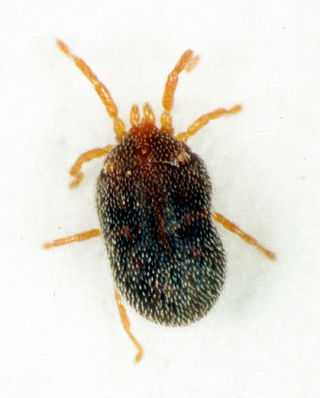
Balaustium is a genus of mites belonging to the family Erythraeidae. These are large red mites with one or two pairs of eyes set well back on the body.
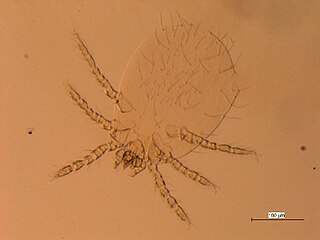
Neotrombicula is a genus of mites in the family Trombiculidae. Species of this genus are found throughout Europe and North America.

Trombidium holosericeum is a species of mite in the genus Trombidium. It occurs in Europe, Asia, and North Africa and is commonly confused with other red mite species.

Trombidium is a genus of mite with about 30 described species.
Trombidium southcotti is a species of mite in the genus Trombidium in the family Trombidiidae. It is found in Iran.

Parasitengona is a group of mites, variously ranked as a hyporder or a cohort, between the taxonomic ranks of order and family.
Abrolophus marinensis is a species of mite belonging to the family Erythraeidae. It is named after the Marine de Farimore, Corsica, where the species was first collected. A. marinensis differs from its cogenerate species in its palptarsus having 2 setae with a tufty tip. It particularly differs from Abrolophus longicollis in its shorter length measurements.
Charletonia cuglierensis is a species of mite belonging to the family Erythraeidae, so named after its type locality. C. cuglierensis belongs to the group of species which possess two setae between coxae II and III. It differs from its cogenerate species by length measurements. It was first found in Sardinia, 6 kilometres (3.7 mi) south of Cuglieri.
Abrolophus mirabelae is a species of mite belonging to the family Erythraeidae. It belongs to the group of species that have comb-like setae.
Erythraeus berninensis is a species of mite belonging to the family Erythraeidae. It belongs to the group of species that has a basifemoral, setal formula 3-3-3.
Allothrombium polikarpi is a species of mite belonging to the family Trombidiidae, first described from Greece.
Podothrombium manolatesicus is a species of mite belonging to the Trombidiidae family, first derived from Greece.

Neotrombidiidae is a family of velvet mites and chiggers in the order Trombidiformes. There are at least four genera in Neotrombidiidae.

Tetranychoidea is a superfamily of mites in the order Trombidiformes. There are about 5 families and more than 2,200 described species in Tetranychoidea.

Abrolophus is a genus of mites in the family Erythraeidae, first described in 1891 by Antonio Berlese.
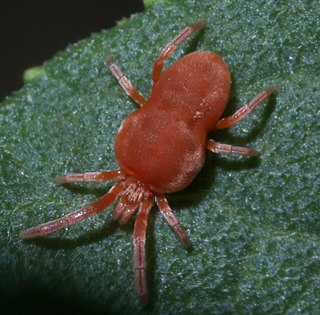
Allothrombium is a genus of mites belonging to the family Trombidiidae.

Dinothrombium is a genus of mites belonging to the family Trombidiidae, which are commonly known as red velvet mites. As suggested by the name, Dinothrombium are covered in fine hairs and they are bright red, sometimes with markings in paler colors. Their bright colours appear to be aposematic, hinting at their unpleasant taste and smell. They are generally fairly large for their family and the African D. tinctorum, where adults typically are 12–14 mm (0.47–0.55 in), is one of the largest known species of red velvet mites. Dinothrombium are found in all the world's continents, except Antarctica, often in dry areas, where they spend most of the time underground in the soil or sand, emerging after heavy rain. During this time, they can be conspicuous and numerous.
Trombidium grandissimum, commonly known as the giant red velvet mite, is a species of mite in the genus Trombidium in the family Trombidiidae. This common mite is endemic to northern and central India, especially in the central plateau, and it primarily inhabits arid regions. T. grandissimum live on the ground and often hidden among soil, but is commonly seen during the rainy season or after recent rain events, and therefore has the nickname of "rain bug".
